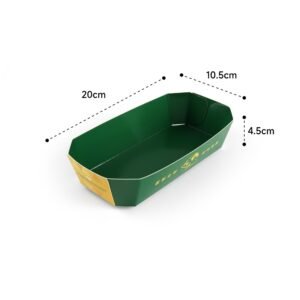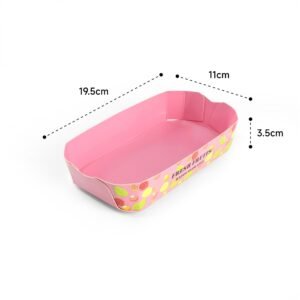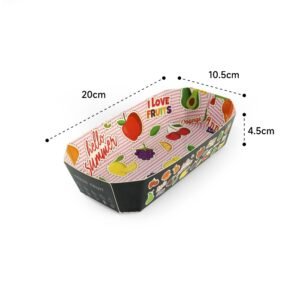What Are the Advantages of PET Plastic Packaging Boxes in the Food Industry?
The widespread use of substandard packaging materials poses serious health risks to consumers, potentially contaminating food with harmful chemicals. This negligence can lead to widespread food safety concerns, product recalls, and long-term health consequences. Choosing PET plastic packaging is a reliable solution to ensure safety, durability, and compliance with industry standards.
Inspiration
PET plastic packaging boxes are highly regarded for their food-grade safety, recyclability, and strength. Their durability ensures product protection during storage and transportation, while their transparency showcases the contents, boosting consumer confidence.
Let’s explore the features and benefits of PET plastic boxes in depth.
Understanding PET Plastic Packaging
Polyethylene Terephthalate (PET) is a type of plastic commonly used in food packaging due to its excellent strength-to-weight ratio and high clarity. PET packaging offers several benefits, including its lightweight nature, impact resistance, and recyclability. These attributes make PET a leading choice for manufacturers aiming to meet strict food safety standards while maintaining sustainability. But what sets PET apart from other plastic packaging options?
Advantages of PET Packaging
Food Safety: PET is FDA-approved for food contact, ensuring no harmful chemicals migrate into the food. Its non-reactive nature makes it an ideal solution for packaging food products like beverages, fruits, and dairy items. The safety of PET plastic is critical in the food industry, where contamination risks must be minimized. This helps avoid potential health hazards and costly product recalls.
Clarity and Presentation: PET plastic has excellent transparency, which allows consumers to see the product clearly. This visual appeal is particularly important for items like ready-to-eat meals, salads, and baked goods, where the appearance of freshness can influence purchasing decisions. PET packaging supports product marketing by improving the overall presentation of the goods, thus enhancing consumer confidence.
Durability: PET containers are highly resistant to impact and are shatterproof. This makes them suitable for packaging delicate food items that need protection during transportation and storage. PET’s strength ensures that the packaging can endure harsh conditions, reducing the risk of damaged goods.
Advantages of PET Packaging
Recyclability and Sustainability: PET is one of the most recycled plastics globally, contributing to a more sustainable packaging solution. Its recyclability helps reduce the carbon footprint of packaging and aligns with eco-conscious consumer trends. Recycled PET (rPET) can be used to manufacture new packaging products, further promoting circular economy practices within the packaging industry.
Barrier Properties: PET has strong barrier properties against moisture, oxygen, and gases. This feature extends the shelf life of food products by preventing spoilage caused by exposure to air and humidity. The barrier properties of PET are especially beneficial for packaging perishable items like meat, dairy, and snacks, ensuring longer shelf stability.
Lightweight Design: PET plastic packaging is lightweight, which reduces transportation costs and energy consumption during distribution. Its ease of handling and transportation makes it ideal for businesses looking to optimize logistics and minimize environmental impact. This is another significant advantage of using PET in food packaging, particularly for large-scale manufacturers.
PET vs. Other Plastics
Compared to other types of plastics, such as polypropylene (PP) and high-density polyethylene (HDPE), PET offers superior clarity and better barrier properties. While PP is often used for hot-fill products and HDPE for more rigid containers, PET stands out in terms of its versatility and safety for direct food contact. Its cost-effectiveness combined with its performance capabilities makes it a preferred choice in many food packaging applications.
Applications of PET Packaging in the Food Industry
The versatility of PET packaging is evident in its wide range of applications. PET containers are commonly used for packaging:<h/em>
Beverages: Bottled water, juices, and carbonated drinks are predominantly packaged in PET bottles due to their strength and clarity.
Pre-packaged Foods: Salads, fruits, and sandwiches benefit from the transparency and protective properties of PET packaging, which keeps them fresh and visually appealing.
Dairy Products: Yogurts and dairy-based beverages are often packaged in PET containers that provide both product safety and extended shelf life.
Industry Trends
The growing demand for sustainable packaging solutions has brought increased attention to recyclable food packaging, eco-friendly plastic containers, and food-grade PET plastic boxes. As consumer preferences shift toward environmentally conscious products, PET’s recyclability and safety make it a top contender in the packaging industry. Keywords like “sustainable PET packaging,” “transparent food packaging,” and “FDA-approved food containers” are rising in search queries, reflecting the industry’s focus on safety and sustainability.
PET plastic packaging offers unmatched safety, recyclability, and durability, making it a top choice for the food industry.
Recent Posts
- What is the Environmental Impact of Compostable Clamshell Containers?
- What Are the Benefits and Challenges of Biodegradable Food Packaging?
- How Is Bagasse Sugarcane Packaging Revolutionizing the Produce Aisle?
- How Can You Make Eco-Friendly Corn Starch Packaging?
- How Can You Craft Biodegradable Containers for Food?
Products
-
 Disposable Containers Delivery Udon Hot Noodles Bento Lunch Box Main Unit Black Microwave Safe Bowl Oval Microwavable Cake Packaging Boxes Trays Food Container PP Round Bowl
Disposable Containers Delivery Udon Hot Noodles Bento Lunch Box Main Unit Black Microwave Safe Bowl Oval Microwavable Cake Packaging Boxes Trays Food Container PP Round Bowl
-
 Green and Environmentally Friendly Biodegradable Compostable Sugarcane Bagasse Paper Box Fiber Pulp Burger Boxs Pancake Potato Slices Food Container
Green and Environmentally Friendly Biodegradable Compostable Sugarcane Bagasse Paper Box Fiber Pulp Burger Boxs Pancake Potato Slices Food Container
-
 Contrasting Colors Paper Food Trays Fruit Trays Food Boats Paperboard Food Trays for Carnivals Fairs Festivals and Picnics
Contrasting Colors Paper Food Trays Fruit Trays Food Boats Paperboard Food Trays for Carnivals Fairs Festivals and Picnics
-
 Paper Food Trays Fruit Vegetable Trays Food Boats Paperboard Food Trays for Carnivals Fairs Festivals and Picnics
Paper Food Trays Fruit Vegetable Trays Food Boats Paperboard Food Trays for Carnivals Fairs Festivals and Picnics
-
 Paper Food Trays Fruit Trays Food Boats Paperboard Food Trays for Carnivals Fairs Festivals and Picnics
Paper Food Trays Fruit Trays Food Boats Paperboard Food Trays for Carnivals Fairs Festivals and Picnics

